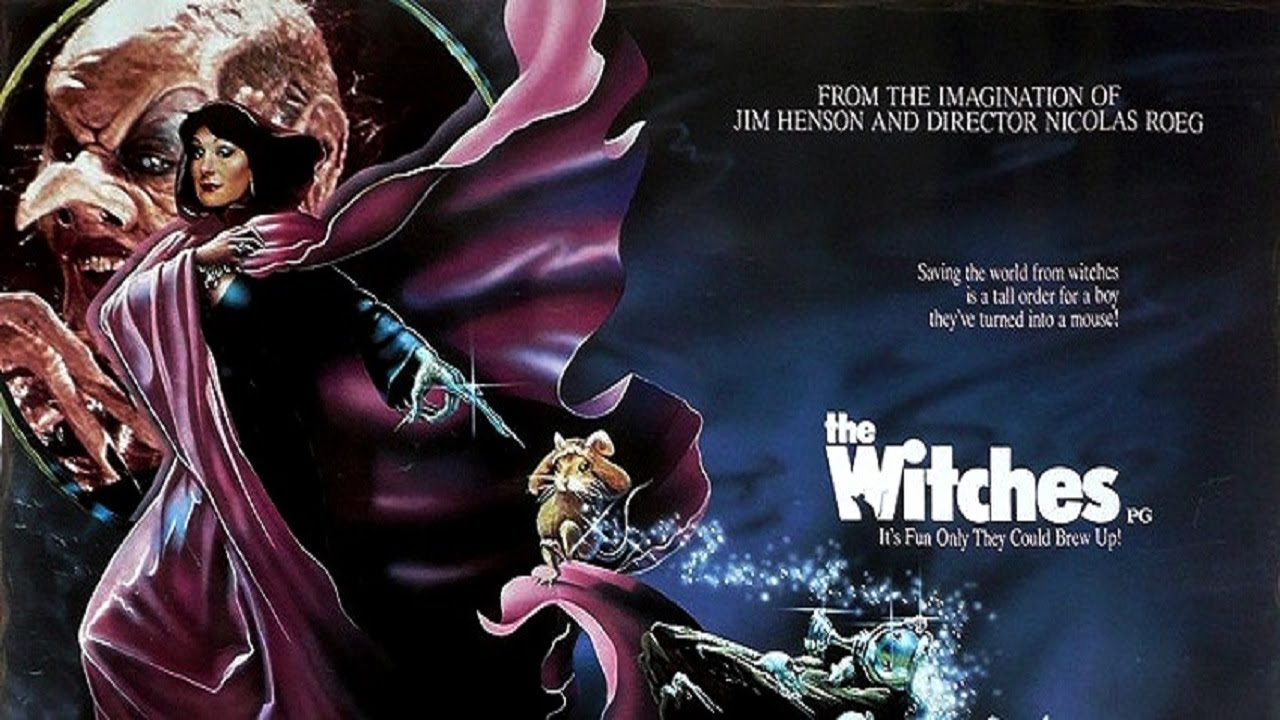
My Time on “The Witches”
“Hi Steve, Can you tell us something about your puppeteering in “The Witches? Thanks!“ – Angie Contreras
“The Witches” is a feature film released in 1990, produced by Jim Henson. Based on a novel by Roald Dahl, whose “short stories are known for their unexpected endings, and his children’s books for their unsentimental, macabre, often darkly comic mood, featuring villainous adult enemies of the child characters.” (From Wikipedia). This was indeed, the case with “The Witches”.
If you haven’t seen “The Witches“, you can click this link and watch it now on You Tube. And THIS LINK has some interesting behind the scenes information.
Well known director Nicolas Roeg (Performance (1970), Walkabout (1971), Don’t Look Now (1973), The Man Who Fell to Earth (1976), Bad Timing (1980) was a very interesting fellow to work with, and it was one of the last films in which Jim Henson was involved. Evidently, it was meant to have been released in the UK the month he died but was delayed.
My understanding is that Roald Dahl was quite unhappy with an alternate, ‘happy’ ending that Jim preferred where the central character, a young boy named Luke (Jasen Fisher) who is changed into a mouse by the Grand High Witch (Angelica Huston), is changed back to a boy. It deviated from the spookier ending in the book, where he remains in his state of rodentia…honestly I sort off like that one, but I understand why it might have been deemed too scary for a younger audience in 1990.
The primary puppet work was done at the end of the shoot. I always had the impression that director Nic Roeg was a little disconnected with the puppet portions as we shot them, as though they were a “necessary evil”, so to speak. In fairness, though key to the film’s story, shooting with puppets was not what Roeg was known for by any means, so it fell to many talented people to work very hard to get the puppet shots using three different sized versions of the Luke and Bruno mice.
Personally, I enjoyed working with Roeg even though it could be a little difficult, at times, to communicate. I saw him as an interesting fellow and obviously an amazing filmmaker, a bit of an eccentric character, who would talk to a group of people around him during set-ups on a fairly noisy set in a very low voice so that everyone was leaning in to hear him. I say that with a chuckle, not with derision, and I look back to the opportunity to have worked with him fondly.
The puppetry was tough using state-of-the-art, yet awkward, puppets in three scales, a very small life-sized mouse to be used in extreme wide shots with human actors, a Doozer-sized rod puppet on a (too) long stick that as controlled with cables for the mouth and head movement, and a large hand puppet in the size range of most of the Muppets.
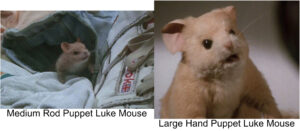
The three scales allowed for practical shooting in real space as opposed to every shot with the lead character as a mouse being a special effect. Remember, this was a time when green screen shots were much harder to achieve with realism, so practical puppetry was the way to go in anthropomorphizing living animals.
It was clear to me early on that if these puppet mice were to do all of the action called for in the script, this was the kind of endeavor that would mean shooting many little snippets of action that likely would not be able to be played in an overall master shot. The three puppet mice all required differing methods of manipulation, but still needed to look seamless when edits were made directly between the versions.
To further complicate things, a forth element was introduced in that these three very different puppets would be integrated throughout the film with shots of an actual live mouse. Not only must the puppets match each other, but the movements of all three needed to match that of a living animal that might be seen in an immediately preceding or subsequent camera shot as a scene played out.
The large hand puppet versions of the two mice were truly beautiful puppets. Covered in fur with cable controlled mechanisms for their eyes, they could be tough to manipulate with the needed subtlety, but they looked quite good. There was only one “Luke” mouse and one “Bruno” mouse hand puppet in this size that were the ‘hero’ puppets to be used for the mice-only close up scenes. In other words, they needed to be cared for and kept pristine and ready for camera.
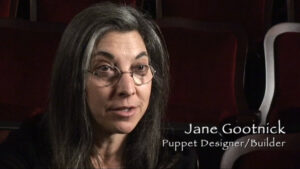 My friend and long time Henson alum, Jane Gootnick, was a big part of the Creature Shop team on set during my time on the film. She and I would sit in the workshop and ponder how to achieve upcoming shots that were scheduled, but not resolved. In many instances the buck stopped with us, and if what was discussed with Nic Roeg was to actually happen, we had to figure out how to make it work with puppets and cameras. Fortunately, Roeg was seemingly quite happy to accommodate the majority of suggestions.
My friend and long time Henson alum, Jane Gootnick, was a big part of the Creature Shop team on set during my time on the film. She and I would sit in the workshop and ponder how to achieve upcoming shots that were scheduled, but not resolved. In many instances the buck stopped with us, and if what was discussed with Nic Roeg was to actually happen, we had to figure out how to make it work with puppets and cameras. Fortunately, Roeg was seemingly quite happy to accommodate the majority of suggestions.
Not unlike all of the Muppets, the large mice were built to be manipulated through the bottom in an upright position. In other words, the puppeteer’s arm entered the figure below the puppet’s waist at the bottom. But, in order for the movement to be as ‘mouse-like’ as possible, there was a particular close up shot that Jane and I determined would require Luke mouse to be seen on all-fours like a real mouse. Sometimes one has to go out on a limb and trust their instincts, but doing this shot in this manner would require ‘chest surgery’ on this very expensive, one-of-a-kind, fur covered puppet in order to open an entry hole for my arm through the chest. It could ruin the puppet for future shots by leaving an irreparable seam right under the puppet’s head, but this shot had to be done at this point in the schedule.
Jane and I tortured over an alternate way to achieve the required camera angle that was to be shot the next day. Could I possibly get into a position that allowed me to work from the base of the puppet? Was there any way to get this shot with the mid-sized version? After what seemed like hours of deliberation, each of us waiting for the other to definitively recognize the writing on the wall, it was clear there was really only one workable choice – a very risky choice: Cut the puppet (risking sabotaging the remainder of the shooting), and hope for the best…
So, that’s what she did. We made an unauthorized executive decision, and, thanks to her expertise, Jane was able to repair the ‘wound’ after the scene was shot so that we were the only ones who knew the risk that had been taken.
As was always characteristic of the way in which Jim valued his team, he made certain his puppeteers were featured in the cast credits, even making a distinction between them and the human cast.
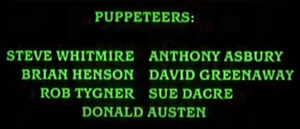
On a personal note, I had spent considerable time in England by 1988 when we shot this film. During production, I stayed in the town of Slough outside London during the shooting. I had no car and weekends were left to public transport if I was to travel into central London. I’d have to take an airport shuttle from the hotel to Heathrow, where I could then take the Tube into town. That trip was about an hour and a half each way, but the alternative was to be remote and isolated in Slough (fun capital of the Outer London…).
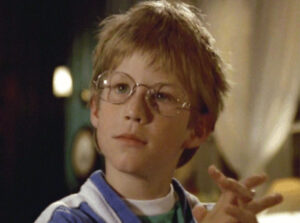
Also in the small hotel was young Jasen Fisher, who played Luke, and his mom, Eraina. As Americans abroad, we would often have dinner in the small hotel restaurant where we would commiserate lamentations of the differences in cultures between what they were accustomed to back home. Of the lead actors in the film, it think it was only Jasen and Mia Zetterling that I met or worked with. All the rest had finished shooting.
Though a lot of “The Witches” was on location, the in-studio stuff was shot at Bray Studios, home of the Hammer Horror films, as well as “The Rocky Horror Picture Show”, amongst many other films in its 50+ year history. Next door to Bray was Oakley Court, the beautiful Victorian country house used as “the Frankenstein Place…” in the film. Then (as now), it was a hotel, and we went there once or twice to sit and talk down our days after shooting. These days, they offer guests a sort of “Rocky Horror” package, but back in the ’80s that didn’t exist. It was just an amazing old estate with a rich history. Still, if you’re a fan of “Rocky Horror” and find yourself in the UK, go there as a day trip or book a stay!
The sound stages at Bray Studios were also extensively used as rehearsal spaces for touring bands like Pink Floyd and The Who. While I was shooting there I noticed massive equipment cases being loaded into one of the stages. I was curious and, upon investigation, it turned out that “The Moody Blues” were rehearsing for an upcoming tour.
I met a couple of the band’s roadies in the canteen who were interested in visiting the shooting for “The Witches”, and I was invited to sit in on the band’s rehearsals between my shooting. It was like having an all access backstage pass.
The “Moody’s” keyboard player at the time was Patrick Moraz, formerly of “Yes”. I had followed Patrick’s work for years dating back to my time playing keyboards in high school garage bands.
Patrick was, by far, the most approachable member of the band, a whimsical musical wizard who surrounded himself with electronic keyboards on stage akin to a scientist in his laboratory. We spent considerable time hanging out during that short timeframe, and later on, he and I spent quite a lot of time hanging out back in Los Angeles at his home in Pacific Palisades for many years during the production of “Dinosaurs”.
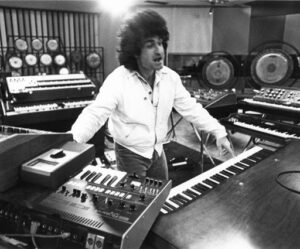
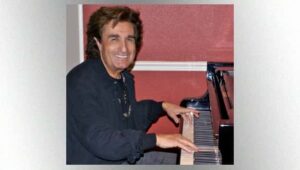
Rather than having a table, Patrick’s dining room space housed a concert grand piano, and I would spend weekends there, sitting and listening to him play for hours as he improvisationally channeled Beethoven (No joke! Listen at this link to music from his “WINDOWS OF TIME“ album where he essentially locked himself in a studio and played whatever came into his amazing musical mind for weeks).
The musical hack that I am, I even had the enormous honor of having him ask me on the spur of the moment to accompany him as he played for a private party at his home while there were very accomplished musicians in attendance. I think he asked me (of all people) because I had nothing to lose, whereas it seemed that many of the more accomplished players were a little reluctant to risk scrutiny playing in front of their piers alongside a legend.
As he improvised he would yell out the next chord I should move into in order for me to keep up with him. He was quite literally using me as a ‘third hand’ to play a bass line as though our minds were connected via a MIDI cable (except that I sucked at it!)
So, like most of my work during the Jim years, lasting relationships, collaborations, and chance encounters that netted a lifetime of connection were, too, a part of “The Witches”.
I understand there is a remake of the film due out next week (shot in my neck of the woods) that will run for Halloween on HBO Max. I’m sure the effects will be quite different, and the tone will be modified with the intent of an update for our times.
It will be interesting to see in today’s world of slick CG characters and the taking of creative liberties with respect to the intent of the originators, if the reboot will retain the macabre air of creepiness within the Roeg/Henson version that even Dahl apparently felt was not creepy enough.
If you see it, let us know your thoughts here.
-S

Justin H Piatt
If I remember right, the Jim Henson Biography by Brian Jay Jones notes that Dahl thought Jim’s version was too dark and creepy, with the idea of a child staying as a mouse to be a “dream come true” rather than turning back into a human. I don’t think Jim could have ever pleased him, as Roald Dahl was notoriously difficult with anyone trying to make a film based on one of his books.
Anne Terri
This is a most exciting vlog for me. I took my two children to see this film, and we absolutely loved it. Being a huge fan of Angelica Huston, made it all the more special. Little did I know then what it took to bring these wonderful tiny mice to life. Thank you, Steve and the brilliant cast of puppeteers for being so careful in how these were presented. I consider this film a masterpiece, even though it took a while for it to catch on. Ironically, I just watched an online, YouTuber’s video about 10 things you do not know about Witches. Obviously, he did not know the behind the scenes information on the puppets and what was necessary to bring them into performance. Thanks for a very interesting blog.
Angie
Wow !! Wonderful stories !! I saw the movie again like Two weeks ago that’s why I wanted to ask you about it … thanks for the answer …
Anne Terri
OMG It’s just like the film. The curse of blindness has been lifted, and I can now see again! Wow Steve, it’s a miracle.
Steve Whitmire
Yes, thanks to Anne’s suggestion, I have changed the font and size of these posts to hopefully help them to be more readable.
-S
Dylan G.
If Dahl hated Jim Henson’s version, then he would’ve absolutely despised the new HBO Max version. That looks like an awful adaptation.
Steve Whitmire
Let me know if you get a chance to watch it. -S